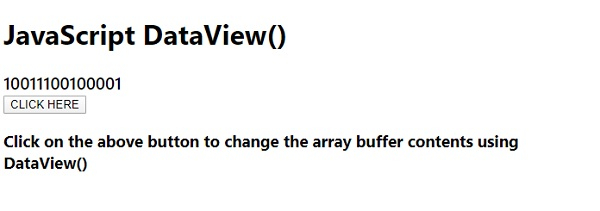
 Data Structure
Data Structure Networking
Networking RDBMS
RDBMS Operating System
Operating System Java
Java MS Excel
MS Excel iOS
iOS HTML
HTML CSS
CSS Android
Android Python
Python C Programming
C Programming C++
C++ C#
C# MongoDB
MongoDB MySQL
MySQL Javascript
Javascript PHP
PHP
- Selected Reading
- UPSC IAS Exams Notes
- Developer's Best Practices
- Questions and Answers
- Effective Resume Writing
- HR Interview Questions
- Computer Glossary
- Who is Who
JavaScript DataView()
The JavaScript DataView allows us for reading and writing in multiple number types in binary ArrayBuffer by providing a low level interface. We cannot manipulate ArrayBuffer directly without using DataView().
Following is the code for implementing JavaScript DataView −
Example
<!DOCTYPE html>
<html lang="en">
<head>
<meta charset="UTF-8" />
<meta name="viewport" content="width=device-width, initial-scale=1.0" />
<title>Document</title>
<style>
body {
font-family: "Segoe UI", Tahoma, Geneva, Verdana, sans-serif;
}
.sample {
font-size: 20px;
font-weight: 500;
}
</style>
</head>
<body>
<h1>JavaScript DataView()</h1>
<div class="sample"></div>
<button class="Btn">CLICK HERE</button>
<h3>
Click on the above button to change the array buffer contents using
DataView()
</h3>
<script>
let fillEle = document.querySelector(".sample");
var buffer = new ArrayBuffer(8);
var view1 = new DataView(buffer);
view1.setInt16(0, 0x2721);
fillEle.innerHTML = view1.getInt16(0).toString(16);
document.querySelector(".Btn").addEventListener("click", () => {
fillEle.innerHTML = view1.getInt16(0).toString(2);
});
</script>
</body>
</html>
Output

On clicking the “CLICK HERE” button −


Advertisements
